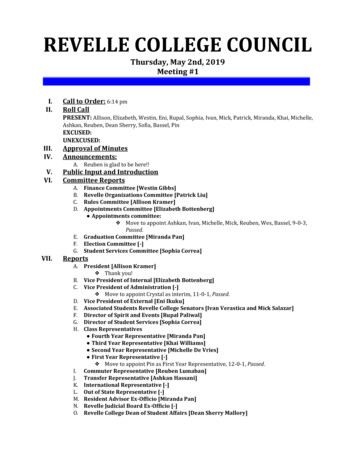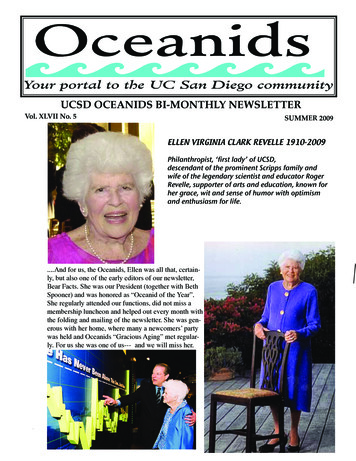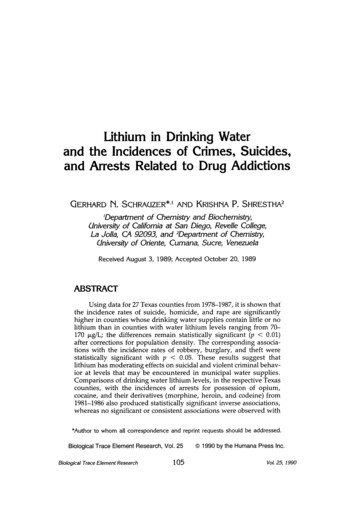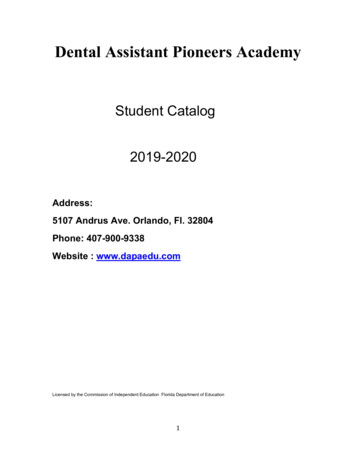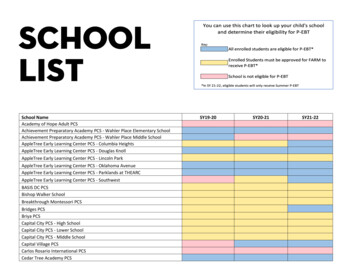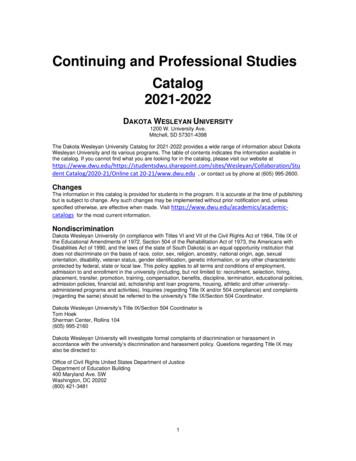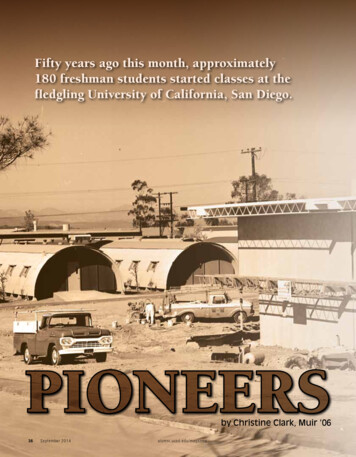
Transcription
Fifty years ago this month, approximately180 freshman students started classes at thefledgling University of California, San Diego.PIONEERSby Christine Clark, Muir ’063 6 S e p t e mb e r 2 0 1 4alumni.ucsd.edu/magazine
All but 30 of the freshmen were science majors andthere were, as a registrar told the press that year,“two boys for every girl.”At the time, there were no freeways near the four year-old univer-All but 30 of the freshmen were science majors and theresity, which was cleaved in half by U.S. 101. The campus was madewere, as a registrar told the press that year, “two boys for everyup of three academic buildings: B, C, and D (building A was thegirl.” According to Penner, a philosophy major, who now workssteam plant), and there were no dormitories. Dirt, not concrete,as a government property administrator for Raytheon, and Rogerfilled what was later to be known as Revelle Plaza. And construc-Carne, Revelle ’68, a math major, camaraderie was strong amongsttion on the Central Library (later renamed Geisel Library) wouldn’tthe small class.break ground for another three years.“Everybody knew everybody, we were all friends,” says Carne,But even so, 181 pioneering students arrived at the relativelybarren mesa on the northern edge of the city. They were the campus’s first undergraduate class, and joined about 280 graduatestudents, some of whom had been at the University since itsfounding in 1960.who now works in software development. “We all took the sameclasses, we were all in the same boat.”The Revelle College curriculum proved to be interesting, butdifficult for the first students.The administration wanted students to be given a broad under-The first college established on campus was aptly named Firstgraduate education in science and mathematics as well as in theCollege, and it remained so until 1965, when it was dedicated inhumanities. They also felt that undergraduates should have a fluenthonor of one of UC San Diego’s founders, Roger Revelle.knowledge of at least one foreign language and take calculus theirBut the freshmen of 1964 had not come for the facilities. Part offirst year. It was a rigorous curriculum.the lure was the promise of an extraordinary faculty, many of whom“I think everybody would have agreed that it was really, reallywere Nobel laureates recruited by Revelle in a series of bold raids ontough,” says Penner. “Everyone was at the top of their high schooltop universities throughout the United States. The Pacific Ocean,class and then all of a sudden, they were thrust together in thiswhich shimmered as a wide, blue crescent below the campus,experimental academic program. Plus, it was new for many of thewas also a draw.faculty too; many had not taught undergraduates before.”Like most of the admitted freshman class, MarshaPenner, Revelle ’68, was a standout high school student fromSan Diego County.Like other freshmen, Carne found the foreign language requirement to be cumbersome.“In addition to passing a written test, the other requirement was“I was just so thrilled to be accepted because I lived in Santo have the ability to have a half hour oral conversation with a na-Diego and I was so excited to go to a new UC campus in town,”tive speaker of a different language,” Carne says. “I chose Germansays Penner, who worked in the physics department for 13 yearsand I did not pass the conversation test the first year, but eventu-after graduation. “We knew that this was really historic. We wouldally after a couple of years, I passed.”be the first of the school’s undergraduates to start traditions, formthe student government and vote on important issues.”Though the inaugural undergraduate class was under intenseacademic pressure, they still managed to have fun.alumni.ucsd.edu/magazineSeptembe r 2014 37
A campus newspaper, Sandscript, was launched in 1965 (seepage 64). Also during this first year, the students voted on aschool mascot. The list of names considered included Dolphins,Barracudas, Grizzly Bears, Hornets and Tritons. In the final balloting between Dolphins and Tritons, the Greek God of the Seawon. Subsequently, Sandscript was renamed Triton Times, and thestudent yearbook was dubbed The Trident.As far as gathering places went, the beach adjacent to ScrippsInstitution of Oceanography at La Jolla Shores was it.Part of the University of California since 1912, ScrippsInstitution of Oceanography was referred to as “the lowercampus.” Students would shuttle from the campus to a small beachhouse next to the pier—it was a place for students to hang out,play frisbee and surf. Here the class considered their unofficialmascot to be “Hot Curl,” a famous surfing cartoon charactercreated in 1963.Clyde Ostler, Revelle ’68, was admitted to UC San Diego in1964 along with four other students from Lakeside High School,all of whom were at the top of their class. Ostler, who earned aM.B.A. from the University of Chicago after graduating with adegree in mathematics from UC San Diego, is now retired afterworking as a senior executive with a major bank. Remembering those“I liked it because we were all kind ofnerdy, but as such a small class, we allhad a chance to be involved in sportsand student government. We all got tobe on our college’s baseball, soccer andrugby teams.”early years, he concedes that the burgeoning campus didn’t have athriving social scene, but the compensation was that everyone kneweach other and often socialized at the beach.In fact, according to Ostler, it was one of their beach trips thathelped pave the way for the establishment of one of UC San Diego’soldest traditions.“One time, during the summer of ’64 before we all startedschool, we spent the day at the beach, and afterwards, we all wentto campus and walked to the top of Urey Hall,” Ostler says. “Wewere lamenting how we didn’t eat the watermelon at the beach, sowe decided to come back and toss it.”The event grabbed the attention of students who later collaboratedwith Bob Swanson, physics professor, on an experiment to determinewhat the terminal velocity of a watermelon drop from the seventhfloor of Urey Hall would be, and how far the sacrificial fruit would“It was great,” says Barker. “I liked it because we were allsplat. Terry Barker, Revelle ’68, Ph.D. ’74, who was an aerospace andkind of nerdy, but as such a small class, we all had a chance to bemechanical engineering major, was one of these students. He wasinvolved in sports and student government. We all got to be onon top of Urey Hall with classmate Liz (Heller) Dahlen, Revelle ’68,our college’s baseball, soccer and rugby teams.” After graduatingthe elected “Watermelon Queen,” and other students for the cam-from UC San Diego, Barker earned an M.Sc. at the Massachusettspus’s official watermelon drop in 1965.Institute of Technology and a Ph.D. from Scripps Institution ofThat pioneering class also started the first intermural athleticclubs in which Barker was active.3 8 S e p t e mb e r 2 0 1 4Oceanography. Barker is now retired after spending most of hiscareer as a staff scientist doing geophysics.alumni.ucsd.edu/magazine
Photos courtesy of Mandeville Special Collections Library, UC San DiegoCrispin Hollinshead, Revelle ’68, also an aerospace and mechanical engineering major, says the tight-knit community of the firstclass provided unique social opportunities.“There were graduate students on campus, but unlike everyother college, the only undergraduates were freshmen, so we wereon top of the heap,” says Hollinshead, now retired from UC SanDiego’s Institute of Geophysics and Planetary Physics (IGPP).“The faculty and administration were new as well, so we felt like wewere all on a level playing field—it was an unusual dynamic as faras the balance of power goes.”The campus’s total population nearly doubled each year,growing from 552 students in 1964 to 3,743 students in 1968.Revelle College’s evolution included the addition of dormitoriesin 1965, which were then referred to as mud huts for their roughtextured exterior. UC San Diego’s second college, named after JohnMuir, was established in 1967. That same year, construction beganon what would become the main library, replacing some of theBefore there was a campus, there was Camp Matthews. Eveningsat Camp Matthews (above) were spent cleaning the 9-pound M1rifles, days were spent training and on the USMC firing line(below). The photos were taken in 1961.familiar Quonset huts, which had housed students and classrooms.The Quonset huts were leftovers from the old Camp Matthews’ Marinebase, which was transferred to the University of Californiain the fall of ’64.But it was not just the look of the campus that would change.From 1964 to 1968, college campuses across the country wereerupting with student activism in response to the escalation ofthe Vietnam War. Demonstrations and sit-ins at UC Berkeley andUCLA were gathering attention, and students at UC San Diegovoiced their opposition to the war as well.Carne recalls participating in various anti-war activities. “Backthen, if you were a student, you got a deferment,” he says. “But assoon as you graduated, you lost that deferment and were subject tothe draft even if you were going to graduate school I was againstthe war. As were many in my generation.In the late ’60s and early ’70s student protests against theVietnam War were common. This “bomb” was placed in RevellePlaza, a center for protest.“I was involved in the La Jolla march and at the time. La Jollawas an extremely conservative community," Carne says, "so residents yelled at us, calling us communists and traitors.”John McCleary, Revelle ’68, who transferred to UC SanDiego as a junior in 1966, to study biology, remembers workingat the registrar’s office when a group of students occupied thebuilding for a sit-in.As part of Revelle College’s development, the paved sweep ofRevelle Plaza emerged as the campus crossroads. A European-esqueopen space, the plaza became the backdrop for protests and theboosting of causes. Students set up tables around its big, squarefountain, seeking signatures on petitions to end the war in Vietnam,and to support other causes.alumni.ucsd.edu/magazineSeptembe r 2014 39
McCleary, who later worked at UC San Diego in computinguntil he retired in 2006, was a graduate student in 1970 and foundhimself studying at Revelle on May 10. It was the day GeorgeWinne, Jr., a graduating senior in history, chose to self-immolate in Revelle Plaza to protest the war in Vietnam.“I heard some commotion and went to find out what hadhappened.It was tragic,” McCleary says. “I think most ofthe students were shocked. It made me take a step back andrethink what was going on. College years are pretty formative asit is, so all this was affecting people in different ways it was adefining moment for the campus.” (A memorial to honor studentactivism for peace was recently unveiled at Revelle College.)By spring of 1968, 77 members of the original class of181 students were eligible to participate in the campus’scommencement ceremony.A group of students, including Ostler, wanted to have agraduation ceremony that reflected what they felt were thevalues of their pioneering class. “Many of us were the first inour family to graduate, so we wanted to have a celebration withour families. We said ‘let’s do away with cap and gown,’ ‘let’spick our own speaker’.”However, according to Ostler, some in the administration balked at the idea of students participating in thegraduation ceremony in plain clothes. As a compromise theUniversity offered to provide caps and gowns free-of-charge,and the students consented to don the traditional commencement wardrobe.Though Ostler was eligible to participate in the ceremony,he opted out in protest. However, 25 years later, Ostler wasasked to give the keynote speech to graduating Revelle Collegestudents, which included his daughter. Ostler, who was bythen a high school teacher, accepted the offer. He was thecampus’s first alum to have a son or daughter graduate fromUC San Diego.Ostler and Carne both say the years they spent as part ofUC San Diego’s first class were some of the best of their lives.Penner echoed similar sentiments and says she still has theUCSD beanie that she received during freshman orientation in1964. In addition to working on campus for 13 years, Pennerearned a second bachelor’s degree from Revelle College incomputer science in 1972.“Having spent decades at UC San Diego, I am continuallyamazed by the campus,” McCleary says. “The campus foundershad really high expectations when constructing the University.I am glad I was lucky enough to be a part of the experience.”Christine Clark, Muir ’06, is a public information representative atUC San Diego.4 0 S e p t e mb e r 2 0 1 4alumni.ucsd.edu/magazineThe interior of one of the ‘classroom’ Quonsets.
PHOTOGRAPHY: SPECIAL COLLECTIONS & ARCHIVES, UC SAN DIEGO LIBRARYLeft to right, Charles Dail, San Diego mayor; Herbert York,chancellor; Clark Kerr, UC president. School of Science andEngineering and Urey Hall groundbreaking, 1961.Roger Revelle speaking at the Revelle College dedicationceremony, October 1, 1965. Standing behind him are (fromleft to right): Edward Goldberg, Revelle College provost;Carl Eckart, vice chancellor for Academic Affairs; JohnSemple Galbraith, chancellor 1964-68; Herbert Frank York,Chancellor 1961-64, 1970-71; and Walter Munk, professorof geophysics.The campus’ total population nearly doubled eachyear, growing from 552 students in 1964 to 3,743students in 1968.alumni.ucsd.edu/magazineSeptembe r 2014 41
top universities throughout the United States. The Pacific Ocean, which shimmered as a wide, blue crescent below the campus, was also a draw. Like most of the admitted freshman class, Marsha Penner, Revelle '68, was a standout high school student from San Diego County. "I was just so thrilled to be accepted because I lived in San
